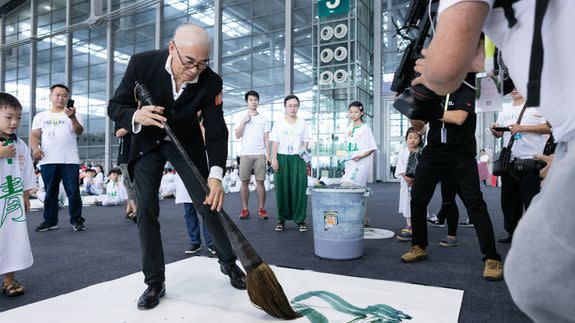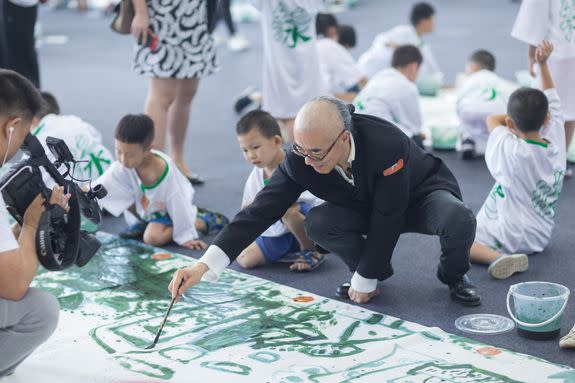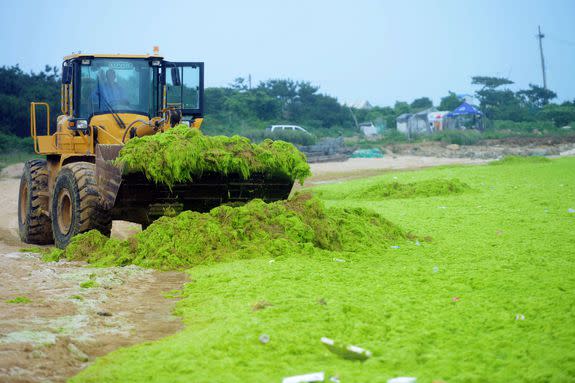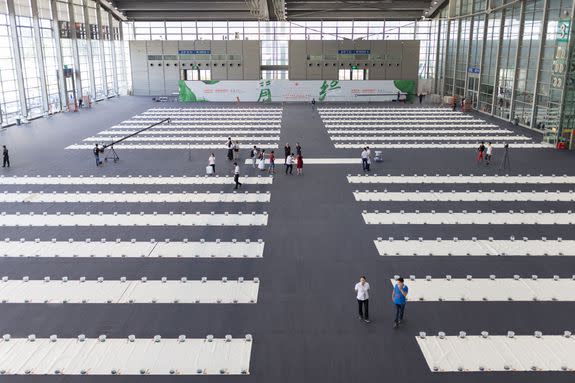Artist paints with algae to highlight China's toxic waters

SHENZHEN, Guangdong — Last month, Chinese artist Gu Wenda led 1,500 schoolchildren in Shenzhen to paint 1,500 square meters of rice paper with algae water.
In a modern riff of traditional “qinglu shanshui” landscape painting — especially popular in the Qing and Ming dynasties — the project aimed to highlight China’s toxic algae blooms.

Image: GU WENDA
SEE ALSO: After China, a Canadian company plans to sell India bottled air from the Rocky Mountains
China has struggled with algae blooms for the past decade. Caused by industrial run-off, they have severely compromised the health of the lakes and rivers and the people who depend on these bodies of water. In some cases, people have been left without drinking water for days.
Just this summer, Qingdao, a port city in eastern Shandong, experienced an algae invasion of over 58,000 hectares. According to a 2014 report, 28 percent of rivers are so toxic that they aren’t even suitable for agricultural use. Thirty-eight out of 71 rivers are unsuitable for humans to touch, according to a report by the State Oceanic Administration of China.

Image: Imaginechina

Image: Xue hun/Imaginechina
“My algae paintings are symbolic of a green China,” Gu says, referring to the color of the algae. “Over the last 30 to 40 years, after senior leader Deng Xiaoping’s Open Door policy, China has vastly grown its economy and international production. This has damaged certain rivers and lakes, causing algae blooms because of chemical run-offs. This is the concern of everybody today.”
For the artwork titled “Verdant Mountains, Emerald Waters", corporate sponsor Ping An Insurance donated 1 million RMB ($148,000) to provide drinking water to schools in rural poor areas in China.

Image: GU WENDA

Image: GU WENDA
Gu says he chose to involve children in his project with the hopes of inspiring them to get into art in the future.
“Contemporary art in China is an import from the West. It is not yet mainstream today,” Gu says. “So when I have kids participate, the hope is that the future of contemporary art is going to be mainstream.”

Image: gu wenda
'Not an activist'
Gu, a multimedia artist who got his start in the 1980s, is known for his creative use of materials. His multi-year project “United Nations” used hair from hundreds of people to weave into illegible text. His project “2000 Natural Deaths” used sanitary napkins and tampons as a medium.
Although he is cut from the same cloth as Ai Weiwei, who also got his start in the 1980s, Gu doesn't identify as an activist. In past interviews, he has described himself as a peacemaker whose main goal is to unify.
“This algae problem is not that controversial because it is already exposed in the government television and government newspaper. It’s already in people’s minds,” he says.
Gu is currently including the children’s work into a complete piece, which will eventually be displayed in a Shanghai art gallery in November.

Image: gu wenda

